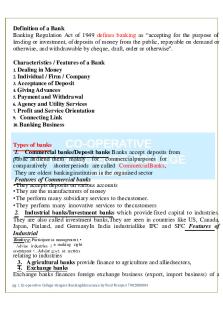Short NOTE ON Endoplasmic reticulum PDF

| Title | Short NOTE ON Endoplasmic reticulum |
|---|---|
| Course | Bsc Biosciences |
| Institution | Jamia Millia Islamia |
| Pages | 2 |
| File Size | 41.1 KB |
| File Type | |
| Total Downloads | 112 |
| Total Views | 150 |
Summary
The cytoplasmic matrix is traversed by an inter-connecting network of membrane bound tubules or cavitics. These cavities remain localized in the endoplasmic portion of the cytoplasm and hence these are called endoplasmic reticula. The occurrence of endoplasmic reticulum varies from cell to cell....
Description
Endoplasmic reticulum (ER) OVERVIEW The cytoplasmic matrix is traversed by an inter-connecting network of membrane bound tubules or cavitics. These cavities remain localized in the endoplasmic portion of the cytoplasm and hence these are called endoplasmic reticula. The occurrence of endoplasmic reticulum varies from cell to cell. While in some cells they are scanty and in others they are in plenty. In some cells such as in egg and embryonic cells endoplasmic reticulum does not occur. Cells which are actively engaged in protein synthesis contain highly developed endoplasmic reticulum. Cells of pancreas, liver, endocrine glands are traversed by a large number of reticula which carry ribosomes on their surface.
Structure. The endoplasmic reticulum is made up of three different types of structures.
(i) Cisternae These are unbranched, flattened sac-like membrane bound structures with a diameter of 40 to 50 mu. They continue to be arranged in bundles in a parallel manner. Cisternae are found in cells that perform synthetic functions.
(ii) Vesicles. These are oval, membrane-bound vacuolar structures with diameters ranging from 25 to 500 micrometres. They are kept in the cell alone.
(iii) Tubules. The reticular system connects the cisternae and the vesicles and is made up of branched structures.
There are two types of reticulum. (a) Smooth endoplasmic reticulum. These are found in cells that do not participate in protein synthesis. Ribosomes are not found with their outer membrane attached.
(b) Granular or rough endoplasmic reticulum. These are found in cells that are actively synthesising proteins. The roughness is caused by ribosome attachment to the endoplasmic reticulum's outer membrane.
Functions (1) Glycogen and some polysaccharides are temporarily stored in the endoplasmic reticulum. (2) Its ramification throughout the cell provides the cell with mechanical support. (3) The endoplasmic reticulum facilitates molecule exchange by osmosis, diffusion, and active transport from the cytoplasm to the nucleus and vice versa. (4) The reticulum is home to a wide range of enzymes. It also increases the surface area available for various enzymatic reactions. These enzymes are involved in the conversion of polypeptides to proteins, proteins to lipids, and lipids to lipoproteins. (5) The reticulum transports all of these substances both inside and outside the cell. (6) RER helps in protein synthesis by providing a place for ribosomes to attach....
Similar Free PDFs

Short NOTE ON Golgi Complex
- 3 Pages

Abul Fazl a short note
- 5 Pages

A Short Note Community Politics
- 16 Pages

Questions on short reports
- 2 Pages

Short Notes on Biosensors
- 3 Pages

Short Essay On Civil War
- 3 Pages
Popular Institutions
- Tinajero National High School - Annex
- Politeknik Caltex Riau
- Yokohama City University
- SGT University
- University of Al-Qadisiyah
- Divine Word College of Vigan
- Techniek College Rotterdam
- Universidade de Santiago
- Universiti Teknologi MARA Cawangan Johor Kampus Pasir Gudang
- Poltekkes Kemenkes Yogyakarta
- Baguio City National High School
- Colegio san marcos
- preparatoria uno
- Centro de Bachillerato Tecnológico Industrial y de Servicios No. 107
- Dalian Maritime University
- Quang Trung Secondary School
- Colegio Tecnológico en Informática
- Corporación Regional de Educación Superior
- Grupo CEDVA
- Dar Al Uloom University
- Centro de Estudios Preuniversitarios de la Universidad Nacional de Ingeniería
- 上智大学
- Aakash International School, Nuna Majara
- San Felipe Neri Catholic School
- Kang Chiao International School - New Taipei City
- Misamis Occidental National High School
- Institución Educativa Escuela Normal Juan Ladrilleros
- Kolehiyo ng Pantukan
- Batanes State College
- Instituto Continental
- Sekolah Menengah Kejuruan Kesehatan Kaltara (Tarakan)
- Colegio de La Inmaculada Concepcion - Cebu









